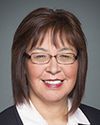That would be possible.
Evidence of meeting #142 for Canadian Heritage in the 42nd Parliament, 1st Session. (The original version is on Parliament’s site, as are the minutes.) The winning word was groups.
A video is available from Parliament.
Evidence of meeting #142 for Canadian Heritage in the 42nd Parliament, 1st Session. (The original version is on Parliament’s site, as are the minutes.) The winning word was groups.
A video is available from Parliament.
5 p.m.
Deputy Minister, Department of Canadian Heritage
That would be possible. We wanted to make sure that we did not exclude those situations. That's precisely why we didn't limit it to self-government or band councils, as you mentioned earlier, and we made indigenous groups broader. For example, the school boards in Manitoba would be a prime interlocutor that, on behalf of the rights holder, could actually say, “We are a big partner in revitalizing languages because we teach it in school.” It's part of the flexibility that we wanted to make sure was preserved, and it's in fact an underpinning of the legislation.
5 p.m.
NDP

Georgina Jolibois NDP Desnethé—Missinippi—Churchill River, SK
That's right.
The other piece is on reserve, making sure that schools, bands and health care have funding sources available to them so that they can continue to teach their languages at the local level.
5 p.m.
Deputy Minister, Department of Canadian Heritage
Or to use them, because you see, it's about reclaiming, revitalizing and promoting.
A big element of promotion is about using it in your services. A self-governing nation, a band council or a Métis government could say, “We want to promote the use of our language by having programs that will make sure that our services are provided in that language.” That would be a perfectly acceptable reason to provide funding.
It's really the three big legs. The promotion can take various forms. It's not just about creating publicity to use languages. It can be through your own institutions. That's why we need to get out of the way and make sure that those things are defined by indigenous groups themselves. Then in turn, as the minister said, we support and make sure that we make it happen.
To be perfectly honest, we also need to track what the practices are that provide the most results, because people are at different places in their journey. Some of them want to reclaim, but eventually they're going to want to promote. They're going to want to look at the nations that have had the chance to have a bigger critical mass of speakers who are in the promotion business to say what works well.
When we have completed reclamation, we can take those best practices and make them multiply.
February 19th, 2019 / 5 p.m.
Liberal

René Arseneault Liberal Madawaska—Restigouche, NB
Thank you, Madam Chair.
Welcome, witnesses. I'm replacing a colleague today. As this committee is not the one I usually sit on, I apologize in advance for any questions I ask that you may consider inappropriate.
I read the minister's speaking notes earlier and you may be able to answer my question. I see that various First Nations were consulted, such as in Whitehorse, Yukon, or the Métis in Manitoba. Reassure me: were the indigenous peoples back home, in the Maritime provinces, consulted?
5 p.m.
Deputy Minister, Department of Canadian Heritage
Yes, we consulted the indigenous peoples of the Maritime provinces, particularly the Mi'kmaq.
5 p.m.
Liberal

René Arseneault Liberal Madawaska—Restigouche, NB
Did you consult all the Algonquin families and sub-families, including the Maliseet?
5 p.m.
Deputy Minister, Department of Canadian Heritage
Yes, we also consulted the Maliseet.
5 p.m.
Liberal
5 p.m.
Manager, Policy and Research, Indigenous Languages Legislation, Department of Canadian Heritage
I would like to add a small nuance. The examples that the minister gave are those of organizations we have worked with to do our outreach, such as the Council of Yukon First Nations. We did the same thing with MK in the Atlantic region.
5:05 p.m.
Liberal

René Arseneault Liberal Madawaska—Restigouche, NB
There are 90 indigenous languages, 75% of which I understand are at risk, in a multitude of communities across our beautiful and very large Canada. I am of Acadian descent, and I know what it is like to fight for your language. My generation had it easy, but it was different for my parents, great-grandparents and ancestors. French was the language of shame, of people who had little hope for a future. So I am sensitive to this whole issue.
In addition, I share Ms. Jolibois' concern about the objectives of the bill and the difficulty in achieving them. As a lawyer, however, I would like to focus on clause 5 of the bill, which sets out the purpose of the act.
Let me give you the example of the Mi'kmaq, who I meet quite frequently in my riding. There is a large reservation on the Quebec side, in Listuguj. On the other side of the bridge near where I live, not far from home, there is a smaller reservation called Eel River Bar. There are also the Maliseet of Edmunston. Among the Mi'kmaq, I learned in powwows that there are different ways of naming things depending on whether the Mi'kmaq come from the Gaspé Peninsula in Quebec, New Brunswick, Nova Scotia or even Cape Breton. They don't always agree on how to refer to something, and I'm not talking about accent, but vocabulary. The Mi'kmaq in Nova Scotia are quite advanced. They have a dictionary, and there is even a mobile app that translates tourist questions into Mi'kmaq, including “Where is the airport?” and “Where is the bathroom?” It is incredible. It's well done, and a lot of progress is being made.
From a practical perspective, is there a common denominator for all these communities that represent the country's 90 indigenous languages, a denominator that could be used to achieve the purpose of the act? Has there been talk of a dictionary, a lexicon, a college, a school? What seemed to be rallying everyone?
5:05 p.m.
Deputy Minister, Department of Canadian Heritage
Coincidentally, one of you asked the minister earlier what he had learned from the consultations. I had an answer to suggest to him, and I'm glad you gave me the chance to give it to you. In fact, the variety of needs and the diversity of indigenous languages are the real wealth to be preserved. It might be risky to try to unilaterally define the elements common to these languages, which could stem from their very long cohabitation since long before the Europeans arrived. However, there are indeed important variants, particularly for Inuktut, the Algonquin languages and the other major linguistic families.
It would be difficult to target any particular common element, except—unless I'm mistaken—the fact that most of these languages are oral. Very few of these languages are written, which makes their preservation all the more urgent. During consultations, it was recommended that we ensure that we have technological support to record, safeguard and preserve the languages that are still spoken so that they can be resurrected should they disappear, as the written form of these languages barely exists at all. It is true that Inuktitut began to be written, but not uniformly.
So there are very few common elements, except for this great diversity. That is why the work must be very specific and very granular. One of the challenges we had in drafting this bill was not specifying in the bill all the details of what needs to be done and how to do it, otherwise we would have run the very real risk of forgetting some along the way. That's why we have decided to do the opposite, to establish principles and guarantee rights in the legislation, and to use specific granular agreements to ensure the preservation, revitalization and promotion of these languages.
I don't know, Mélanie. You keep on saying yes.
I would like you to add your comments on that.
5:05 p.m.
Manager, Policy and Research, Indigenous Languages Legislation, Department of Canadian Heritage
During our discussions, it proved very difficult to define the concept of language rights. Everyone agreed not to limit this right, but rather to keep the interpretation broad.
However, we tried to identify examples of communities' efforts to maintain and revitalize their language. We talked about language nests, an expression that did not really exist in French. I'm still looking for a translation for it.
5:10 p.m.
Liberal
5:10 p.m.
Manager, Policy and Research, Indigenous Languages Legislation, Department of Canadian Heritage
Yes, we could talk about foyers linguistiques or apprentissage linguistique in French.
So these are examples of what we have tried to do. However, one of the common elements was not to limit this right.
5:10 p.m.
Liberal

René Arseneault Liberal Madawaska—Restigouche, NB
I understand what you have tried to do and the concept of granularity, given the very vast richness of this linguistic diversity that we don't want to lose because it is part of our beautiful country's history.
5:10 p.m.
Conservative

Martin Shields Conservative Bow River, AB
Thank you, Madam Chair. I appreciate this extension from the previous hour of the conversation we're having.
Deputy Minister, as you know, I have some very specific opinions on clause 7, where you use the word “diverse”. It's a personal thing to me. You slipped into using another word. You said “diverse” a couple of times and then you said “variety”, and I said, “Bingo, I win.” When you use “diverse”, for me there's a lot of context around that word. If you use “variety”, I'm with you.